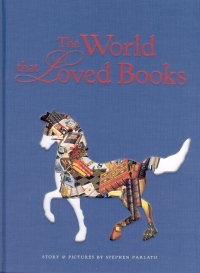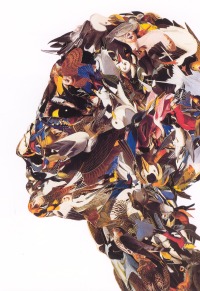| ________________
CM . . .
. Volume X Number 18 . . . . May 7, 2004
excerpt:
We all read at various times for different reasons. Sometimes we simply want to be entertained by, for instance, a funny story while, at other times, we crave the mental challenge that can be found in solving the crime in a mystery novel before the author’s detective does. Or, we could desire to visit the past via an historical novel, the future in science fiction or an alternate world through fantasy. There are also those times when we get so immersed in our reading that we vicariously “become” part of the story. It is to this vicarious experience that can be found in reading that author/illustrator Parlato speaks in The World That Loved Books.
As the review’s opening excerpt indicates, Parlato considers reading to be transformative, and consequently the man who read about flowers becomes flowers, and the rabbit who read about turtles becomes turtles, “his perfect little cottontail now a sea turtle’s flipper.” In all, there are 16 such reading transformations which include a large, ungainly rhinoceros which becomes delicate butterfly wings, a cat that consists of “mice, rats & hamsters” and a dinosaur who became “frogs & salamanders” because “he found the book to be very ribbiting.” Parlato’s occasional bits of humor extend beyond the verbal pun, like the previous “ribbiting,” and can also be visual, such as in the closing illustration where the timorous little mouse is made up of elephants. Readers, both young and old, could pore over Parlato’s detailed collage illustrations for hours as each viewing seems to reveal something new. Art teachers, even in high school, will want a copy of The World That Loved Books to use as an example of how collages can be created from found print materials, and language arts teachers across the grades will also appreciate the title for its ability to concretize one of the benefits of reading. Everyone, however, needs to heed the verb tense used by the author in the book’s opening sentence and do her/his part to change it. A “must-buy.” Highly Recommended. Dave Jenkinson teaches courses in children’s and adolescent literature in the Faculty of Education, the University of Manitoba.
To comment
on this title or this review, send mail to cm@umanitoba.ca.
Copyright © the Manitoba Library Association. Reproduction for personal
use is permitted only if this copyright notice is maintained. Any
other reproduction is prohibited without permission.
NEXT REVIEW |
TABLE OF CONTENTS FOR THIS ISSUE
- May 7, 2004.
AUTHORS |
TITLES |
MEDIA REVIEWS |
PROFILES |
BACK ISSUES |
SEARCH |
CMARCHIVE |
HOME |

 The first hint that The World That Loved Books is not just the usual picture book can be observed as soon as readers pick up the book. The volume’s hard cover contains a large silhouette cutout of a prancing horse. As the readers’ eyes focus on the backdrop beneath the cutout, they will recognize that the horse’s body consists of books or pages from books. Opening the cover to reveal what lies beneath uncovers a profile collage illustration of a man’s head and neck, both consisting entirely of books or pages from them.
The first hint that The World That Loved Books is not just the usual picture book can be observed as soon as readers pick up the book. The volume’s hard cover contains a large silhouette cutout of a prancing horse. As the readers’ eyes focus on the backdrop beneath the cutout, they will recognize that the horse’s body consists of books or pages from books. Opening the cover to reveal what lies beneath uncovers a profile collage illustration of a man’s head and neck, both consisting entirely of books or pages from them.